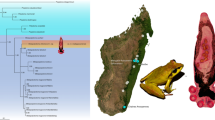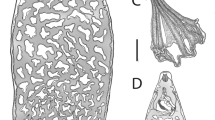Summary
We describe the haptoral sclerites, ciliated cells and chetotaxy of the oncomiracidium ofPolystomoïdes collected in the gullet of freshwater Chelonia (Clemis caspica var.leprosa) from the Tunis areas.
When we compare the oncomiracidia of the presently known Polystomatidae, i.e.Polystoma, Eupolystoma, Protopolystoma andPolystomoïdes, the following basic features are revealed: Ciliated cell pattern: there are a total of 55 cells (including 1 apical, and 12 haptoral) inPolystoma andEupolystoma; and 64 cells (including 2 apical and 16 haptoral) inProtopolystoma andPolystomoïdes.
Haptor: Rudiments of one pair of hamuli are identified inPolystoma andEupolystoma, butProtopolystoma andPolystomoïdes show two pairs.
A further correlative aspects of their biology confirms both resemblances betweenPolystoma andEupolystoma on the one hand, andProtopolystoma andPolystomoïdes on the other hand; the former are parasites of amphibian hosts, the latter of fundamentally aquatic ones.
There is no correlation with their hosts sincePolystomoïdes is a parasite of Chelonia, andPolystoma, Eupolystoma andProtopolystoma are parasites of Amphibia.
TheProtopolystoma, parasites ofXenopus, are more related to thePolystomoïdes, parasites of Chelonia than to all the other Polystomatidae from Amphibia.
Résumé
L'oncomiracidium dePolystomoïdes Ward, 1917 parasite de Chéloniens, s'apparente par de nombreux caractères morphologiques (cellules ciliées, chétotaxie, armature du hapteur), mais aussi par la biologie de l'hôte, au genreProtopolystoma parasite deXenopus. Ces mêmes caractères les différencient des autres Polystomatidae d'Amphibiens (Polystoma etEupolystoma).
Similar content being viewed by others
Bibliographie
Combes, C., Lambert, A.: La chétotaxie des larves nageantes de Polystomes européens (Monogenea). Ann. Parasitol. hum. comp.50, 25–37 (1975)
Combes, C., Lambert, A., Bourgat, R., Salami-Cadoux, M.L.: L'oncomiracidium deEupolystoma alluaudi (de Beauchamp, 1913) Monogène parasite deBufo regularis Reuss en Afrique. Bull. Mus. Nat. Hist. nat. (sous presse)
Tinsley, R.C., Owen, R.W.: Studies on the biology ofProtopolystoma xenopodis (Monogenoidea): the oncomiracidium and life-cycle.Parasitology 71, 445–463 (1975)
Author information
Authors and Affiliations
Rights and permissions
About this article
Cite this article
Lambert, A., Combes, C., Ktari, M.H. et al. Morphologie de l'oncomiracidium dePolystomoïdes Ward, 1917 (Monogenea) et situation du genre parmi les Polystomatidae. Z. Parasitenkd. 56, 175–181 (1978). https://doi.org/10.1007/BF00930748
Received:
Issue Date:
DOI: https://doi.org/10.1007/BF00930748




